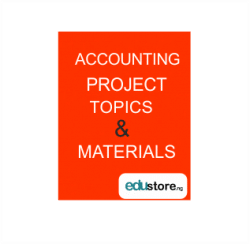An Evaluation Of Capital Structure And Profitability Of Business Organisation (A Case Study Of Selected Quoted Companies)
Abstract of Evaluation Of Capital Structure And Profitability Of Business Organisation
Capital structure is the proportion or each type of capital debt and equity used by a business organisation. Many organizations employ debt in their capital structure because of its benefits. One of the benefits is that interest on debt is tax deductible and reduces tax liability of the organizations concerned. Furthermore, failure to pay interest commitment can result to financial backwardness. The financial managers consider so many factors in their capital structure decisions because of the implications in the use of debt. The factors are cost of capital, debt capacity cash flow. Etc.
The primary aim of business organisation is to make maximum profit if possible. The researcher made a study of selected quoted manufacturing and oil servicing companies to see how capital structure related to profitability of business organizations.
Five companies were selected and their financial statements for four years extracted and analyzed. The analysis showed that there is a strong relationship between capital structure and profitability between debt equity ration and shareholders’ return. It means that the cost of debt in the companies put together is less than their return on investment. A company having return on investment greater than cost of debt will have an increasing shareholders’ return.
PROJECT PROPOSAL
This research will be based on an evaluation of capital structure and profitability of business organisation. The capital structure is the long-term capital requirement of the company which shows how the firm will be finance. And how the profitability of this company will be determined whether it will remain in business or not especially in the long-run.
In the course of doing this we will bring about the problems that will crises, the significance, objective of the study and the limited and the scope of the study.
Chapter two will deal with the collection of information from companies and textbooks i.e. (secondary source of data). This will aid to develop our question for developing of chapter three.
Chapter three will define the research methodology and sources of data used which can be with questionnaire or interviews method. This will help us to acquire information from field works ie our case study.
Chapter four will deal with the presentation, analyzing and interpretation of data by using the sample size to determine the population to conduct research.
Chapter five will deal with the conclusion, summary and the recommendation including the bibliography.
Table of contents of Evaluation Of Capital Structure And Profitability Of Business Organisation
Title page
Approval page
Dedication
Acknowledgement
List of tables abstract
CHAPTER ONE: INTRODUCTION
1.1 Background of the study
1.2 Statement of the problem
1.3 Objective of the study
1.4 Significance of the study
1.5 Scope and limitation of the study
1.6 Research hypothesis
1.7 Definition of terms
Reference
CHAPTER TWO: LITERATURE REVIEW
2.1 Implication of capital structure
2.2 Determinants of capital structure
2.3 Feature of appropriate capital structure
2.4 Concept of cost of capital
2.5 Capital structure theories
2.6 Existence of optimum capital structure traditional view
2.7 Criticism of traditional view
2.8 Modigliani and miller propositions
2.9 criticisms of Modigliani and miller propositions
2.10 Capital structure and corporate tax
2.11 Concept of profit and profitability
Reference
CHAPTER THREE: RESEARCH DESIGN AND METHODOLOGY
3.1 Research design
3.2 Sources of data
3.3 Population and determination of sample size
3.4 Methods of investigation
Reference
CHAPTER FOUR: PRESENTATION, ANALYSIS AND INTERPRETATION OF DATA
4.1 Analysis of data
4.2 Test of Hypothesis
CHAPTER FIVE: SUMMARY OF FINDING CONCLUSION AND RECOMMENDATION
5.1 Summary of finding
5.2 Conclusion
5.3 Recommendations
Bibliography
Appendices
Chapter one of Evaluation Of Capital Structure And Profitability Of Business Organisation
The most important decision all corporate managers should take into consideration is the way in which the long-term capital requirements of their companies should be financial. Capital structure is the permanent financing of a firm represented primarily by equity and long-term liability without including all short-term credits. Many factors have to surface in order to determine the capital structure of a business organisation. These factors are what the financial managers consider first in order to determine appropriate capital structure suitable to his firm. Some of the factors are: cost of capital, floation costs, size of the company, government policies and market condition. The combination of debt and equity has some implication. The first is that debt-equity ratio, which is regarded as an indicators of risk. According to Samuel etal (1992:44) high fixed interest commitment which must be paid by the business organisation irrespective of whether profits are made or not. Debt capacity which is the ability of a firm to service its debt payment of interest and
GET FULL WORK
DOWNLOAD COMPLETE WORK- For Reference Only: Materials are for research, citation, and idea generation purposes and not for submission as your original final year project work.
- Avoid Plagiarism: Do not copy or submit this content as your own project. Doing so may result in academic consequences.
- Use as a Framework: This complete project research material should guide the development of your own final year project work.
- Academic Access: This platform is designed to reduce the stress of visiting school libraries by providing easy access to research materials.
- Institutional Support: Tertiary institutions encourage the review of previous academic works such as journals and theses.
- Open Education: The site is maintained through paid subscriptions to continue offering open access educational resources.





